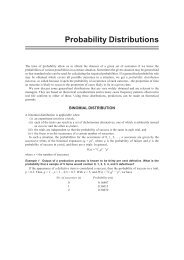International-Business-Dr-R-Chandran-E-book
International-Business-Dr-R-Chandran-E-book
International-Business-Dr-R-Chandran-E-book
Create successful ePaper yourself
Turn your PDF publications into a flip-book with our unique Google optimized e-Paper software.
235<br />
<strong>International</strong> <strong>Business</strong>- <strong>Dr</strong>. R. <strong>Chandran</strong><br />
intensive goods ‘X’ than capital intensive goods ‘Y’ and thus has an<br />
advantage in the production of ‘X’. The production possibility curve AA1,<br />
of country A shows relative abundance of capital while the production<br />
possibility curve BB1 of country B shows relative abundance of labour.<br />
Thus country A will have a bias towards the production of capital intensive<br />
goods ‘Y’ while country B will be more inclined to produce labour intensive<br />
goods ‘X’.<br />
The nature of this bias is illustrated in the diagram. If both countries produce<br />
both the goods in the same proportion, it will be represented by the ray OR.<br />
The production of country A will be represented by the point S while that of<br />
country B will be represented by point S’ on their respective production<br />
possibility curves. The slope of country A’s production possibility curve at<br />
S’ is steeper than the tangent P1P1 than the slope of the production<br />
possibility curve of country B at point S shown by the tangent P2P2. This<br />
implied that good Y is cheaper in country A than in country B and that good<br />
X is cheaper in country B than in country A.<br />
As it is clear from the respective price lines P1P1 and P2P2, the operating<br />
cost of expanding production of goods Y is lower in country A than country<br />
B and vice-versa for good X.<br />
This shows that the capital rich country A has a bias in favour of capital<br />
intensive goods Y and the labour abundant country B has a bias in favour of<br />
prevailing Labour intensive goods X.<br />
Comparison of Ricardian and Factor Endowment Trade Models<br />
Ricardian Heckscher-Ohilin<br />
One factor model (labour)<br />
Two factor model<br />
(labour and capital)<br />
Comparative advantages on the basis<br />
Comparative advantage is of production conditions along with<br />
determined by the production the market demand pattern of goods,<br />
condition alone and it leads to because the price determined the<br />
export.<br />
demand for goods may not always<br />
lead to export<br />
Classical theory of international<br />
trade is totally different from internal<br />
trade and hence requires a separate<br />
theory to explain the causes the trade<br />
Heckscher-Ohilin theory regards<br />
international trade as arising from<br />
differences in factor endowments and<br />
deals with it specific to international<br />
trade<br />
Ricardian theory does not take factor More realistic theory as it is based on<br />
Only for Private Circulation





